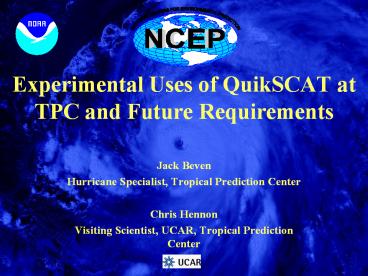Experimental Uses of QuikSCAT at TPC and Future Requirements - PowerPoint PPT Presentation
1 / 20
Title:
Experimental Uses of QuikSCAT at TPC and Future Requirements
Description:
Hurricane Specialist, Tropical Prediction Center. Chris Hennon ... Erika (45 kt from aircraft) Fausto (2003) distance between. positions = 56 mi ... – PowerPoint PPT presentation
Number of Views:11
Avg rating:3.0/5.0
Title: Experimental Uses of QuikSCAT at TPC and Future Requirements
1
Experimental Uses of QuikSCAT at TPC and Future
Requirements
- Jack Beven
- Hurricane Specialist, Tropical Prediction Center
- Chris Hennon
- Visiting Scientist, UCAR, Tropical Prediction
Center
2
Outline
- Operational Applications and Examples of QuikSCAT
- Applied Research
- Auto center detection
- Dealing with rain
- Future
- WindSat
- Operational Requirements and Desires
3
Does a circulation center exist? Is this center
fix accurate?
Is this a valid representation of the 34 kt. wind
radii?
Is 50 kt an accurate MSW measurement?
How timely is the QSCT Pass?
Isabel (45 kt from Dvorak)
4
Operational Examples
5
A good center location
6
A bad example - QuikSCAT can fail to detect
circulation centers, even in tropical storms or
hurricanes
Erika (45 kt from aircraft)
7
When a center is found, it is frequently in the
wrong place
Fausto (2003) distance between positions 56
mi
NRCS analysis may provide a more accurate center
8
QuikSCAT Research at TPC
9
Auto Center Detection
- Motivation
- For TDs and TSs, QuikSCAT solution contains a
discernable fix about 35 of the time - The ambiguity field may contain a circulation
center not shown in the solution field - In general, operational time constraints do not
allow a manual ambiguity analysis - An automated ambiguity analysis procedure will
identify any possible circulations and assign a
confidence level to each - Confidence based on directional probabilities
embedded in data
10
Draw 4 x 4 degree (or user specified size) box
around chosen location
11
(No Transcript)
12
Rain Contamination
- Rain severely limits QuikSCAT usefullness for
- Wind Radii estimation (esp. 50 and 64 kt.)
- Circulation center detection
- Maximum wind estimation
- Can we correct the retrieved wind speeds based
on the rain rate?
13
Operational Rain Correction?
- Need QuikSCAT retrieved wind speed, hi-res rain
rate, and true wind speed to develop an
algorithm - Accurate rain rate generally not available (no
radiometer on board) - Good surface wind speed analysis for TCs
difficult if not impossible in most situations - Can MUDH rain probability serve as a proxy for
rain rate? - MUDH considers brightness temperature and
normalized beam difference two parameters that
should be correlated with rain rate - If so, than a correction algorithm may be
developed - Two TRMM/QuikSCAT coincident passes analyzed
14
(No Transcript)
15
Can WindSat Provide Usuable TC Retrievals?
16
Fabian (2003)- Verification against QSCAT
Rain Not Likely
Rain Likely
17
Verification against surface wind analysis
(Fabian 3 Sep. 2003 2147 UTC)
Very Large (gt 10 m/s) differences over much of
the storm
HWind Wind Speed
Highest differences exactly match heavy rain
areas
WindSat Rain Rate (experimental)
Generally good agreement around storm periphery
WindSat HWind
Figures courtesy of Ian Adams (UCF)
18
Isabel (2003)
QuikScat September 15
Windsat September 14
WindSat figure courtesy of Zorana Jelenak (NESDIS)
19
Summary
- QuikSCAT has been useful in many cases for
operational application - Center detection, location, wind radii
- Rain impacts and lack of rain information severly
limits further use of QuikSCAT winds - Preliminary TC WindSat looks not encouraging
- Development continues
20
Requirements for Future Missions
- Wind measuring instrument and rain detection
instrument on the same satellite CMIS
instrument on NPOESS will fulfill this - Less ambiguity in the measurements
- More coverage!
- New techniques (physical, model function)
- Limit rain effects
- Developed specifically for tropical cyclones































